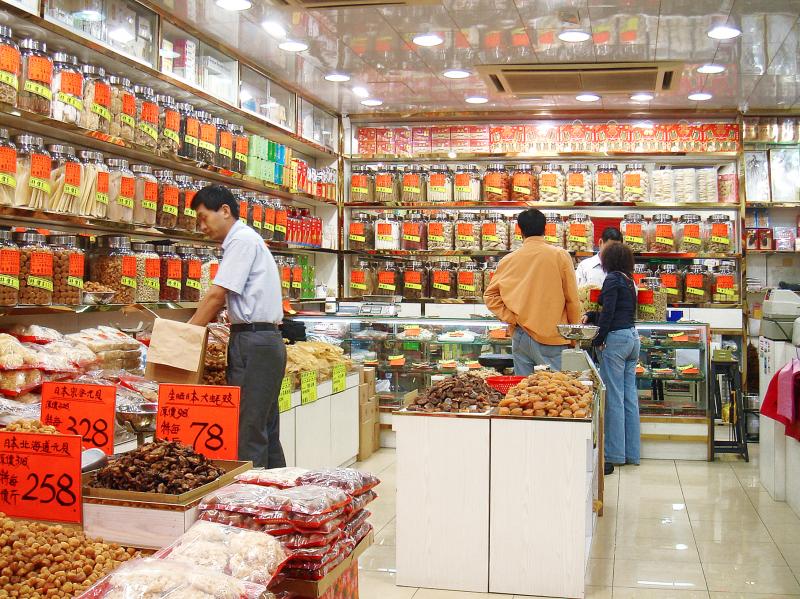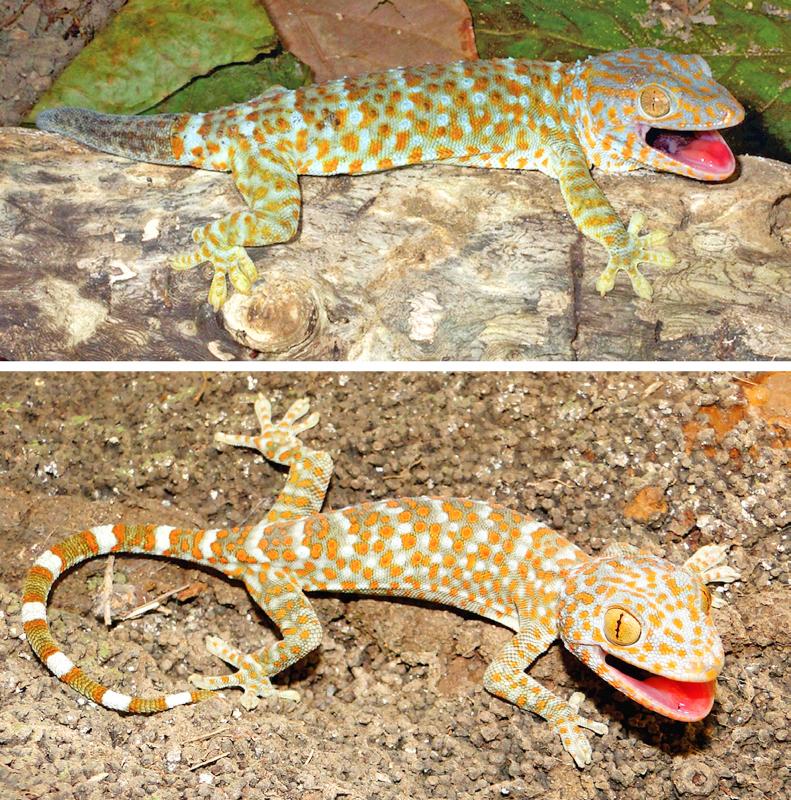Across Asia humans in rural areas are in constant contact with the Tokay Gecko, which takes its name from the noise it makes in many Asian languages and in English as well. Reaching up to 30-40cm in length and capable of inflicting a nasty bite, it preys on insects and small vertebrates, with snacks of fruit in between.
Its range extends from northeastern India, across Nepal and Bhutan and then down through southeast Asian countries like Malaysia, the Philippines, Indonesia and on to New Guinea. Sometimes kept as a pet elsewhere in the world, it has been introduced into the US in Hawaii and Florida, where it has become a destructive invasive species.
DECIMATING POPULATIONS

Photo courtesy of Wikimedia Commons
In Chinese medicine, Tokay Geckos are in high demand. Hence, across Asia, this useful and important lizard is being ruthlessly exterminated.
Though a few go to the pet trade, each year probably a million or more of these large reptiles are captured, killed and prepared for use in Chinese “medicine” to “treat” cancer, asthma, diabetes and (inevitably) erectile dysfunction (is there some Chinese “medicine” that doesn’t treat that?), among a host of diseases. In some Asian countries wine or whiskey made with Tokay Gecko is consumed as an (what else?) aphrodisiac.
Moreover, from time to time new uses are sadly found. For example, from 2009 to 2011 the gecko enjoyed a brief vogue as a “treatment” for HIV, which naturally spiked demand.

Photo courtesy of Wikimedia Commons
It goes without saying that these “treatments” have no basis in scientific fact. This completely unnecessary and pseudoscientific demand for the Tokay Gecko has decimated the species, reducing it by 50 percent across much of its range, according to some estimates.
Most of the demand goes to China (in 2011 an epic shipment of 1.2 million dried geckos was busted on its way to Hong Kong from Java). But with Chinese medicine in wide use in Taiwan, dead geckos find their way here by the tonne. Between 2004 and 2013, Taiwan imported over 15 million geckos, with just over 70 percent from Thailand and the remainder largely from Indonesia.
ILLEGAL GECKO TRADE

Photo courtesy of Wikimedia Commons
This massive demand has stimulated an equally massive illegal trade. In India, for example, the trade in Tokay Geckos has piggy-backed on networks established to move smuggled elephant, tiger, and rhinoceros parts. Across northwestern and western India, poachers catch the geckos, which mature and alive can be worth US$600 to US$2,500 US each, and then ship them to Myanmar, whose Tokay Gecko populations have been depleted, through Bangladesh. From there they go on to Thailand.
The geckos are caught by injecting gasoline into cracks in the rocks or trees where they are likely to be found. Sometimes poachers set fires to chase them out, with all the attendant dangers of forest fire. It goes without saying that India made it illegal to trade in or keep Tokay Geckos in 1972.
There is a legal trade in farmed Tokay Geckos, ostensibly for pets (it is easy to find them on Web sites where pets are advertised and sold) as well as medicine. In Thailand farmed geckos fetch over US$300 each when they reach 15-16 inches in length. Although proponents suggest that this reduces poaching, reports from wildlife organizations show that the legal trade simply acts as a channel for smuggling illegal wild geckos.
In Indonesia, for example, which operates a quota system for Tokay Gecko exports, it appears that far more animals are exported than are farmed, according to Traffic, an NGO working to ensure that trade in wild plants and animals is not a threat to the conservation of nature. Moreover, dead geckos are illegal to export, yet by some estimates Indonesia was exporting over 1 million dried Tokay Geckos annually.
Along the way occurs the usual madness when crime gangs are making money doing something illegal: official corruption, extortion, blackmail and murder. Poor workers, hoping for quick money, switch into the illegal trade, often earning them only prison sentences.
Because it is an illegal product manufactured by criminals, fraud is widespread — proponents of Chinese “medicine” who scoff at Big Pharma’s practices seldom concede that traditional medicine is even worse. Gecko merchants have been caught disfiguring monitor lizards in order to pass them off as gigantic geckos. Because they are sold by weight, live geckos are often injected with mercury to make them heavier. This kills them in a few days. The mercury remains, to be ingested by the patient.
This trade also threatens other Asian lizards, particularly Agamid Lizards. Common across Asia, Agamid Lizards are often killed and marketed as “geckos.” Researchers have spotted them in markets as far away as Afghanistan, killed and prepared like geckos. In one 1999 study in China 16 different lizards were found in “medicines” marketed as made from Tokay Geckos.
As a recent piece in Foreign Policy trenchantly put it, “in China traditional medicine is Big Pharma.” In China “traditional medicine” is part of establishment medicine, with hospitals in every major city and a special government department to oversee it.
“Imagine that every major European city had a university that taught that the Earth is flat and merely 6,000 years old and a hospital that practiced bloodletting and aura cleansing,” observed the Foreign Policy piece.
Thus, demand for Tokay Geckos in China is institutionalized and government supported, making it nearly impossible to stop, and driving Beijing to fight conservation efforts. Beijing also encourages “research” into this pseudoscience, distorting real scientific work and diverting precious resources to pointless studies.
DISRUPTING ECOSYSTEMS
Like any relatively large vertebrate, Tokay Geckos play a vital role in local ecosystems. They eat creatures that humans regard as pests, meaning that a large decline in their population increases human mortality from diseases like dengue and malaria. Because they are large creatures, they provide food for carnivores, especially snakes.
In addition to disrupting ecosystems by removing the animals, humans also introduce them, creating destructive invasive species. In Taiwan Tokay Geckos were twice found in the Japanese period, and the Republic of China (ROC) government later placed them on the protected species list. In 2008 a large individual was found near Taichung harbor, suggesting that it was an escapee from the pet trade. No breeding population has been found on Taiwan. However, since some local Buddhists practice the destructive Buddhist habit of releasing animals into the wild to gain merit, it appears that it is only a matter of luck that Tokay Geckos are not yet denizens of Taiwan’s remaining wild areas.
Fortunately for the Tokay Gecko and the ecologies it both lives in and threatens, last year the Convention on International Trade in Endangered Specie (CITES) listed it in Appendix II as a threatened species. Both China and Indonesia objected (of course). This may enable better regulation of the trade and reduce the threat of poaching. Yet, the money is so great — scammers in Thailand last year found a mark willing to discuss paying over a million baht (US$33,000) for one large lizard — that the pressure to poach them will remain.
This suggests that real salvation for the lizards will not be found in regulating the trade, since regulation has to date led only to expanded illegal trade and increased threat to Asia’s eroding lizard populations. The real answer is for these societies to embrace science-based medicine and end their demand for pseudoscientific “medicines” made from dead animal parts.
Long-time resident Michael Turton provides incisive commentary informed by three decades of living in and writing about Taiwan.

Exceptions to the rule are sometimes revealing. For a brief few years, there was an emerging ideological split between the Democratic Progressive Party (DPP) and Chinese Nationalist Party (KMT) that appeared to be pushing the DPP in a direction that would be considered more liberal, and the KMT more conservative. In the previous column, “The KMT-DPP’s bureaucrat-led developmental state” (Dec. 11, page 12), we examined how Taiwan’s democratic system developed, and how both the two main parties largely accepted a similar consensus on how Taiwan should be run domestically and did not split along the left-right lines more familiar in

As I finally slid into the warm embrace of the hot, clifftop pool, it was a serene moment of reflection. The sound of the river reflected off the cave walls, the white of our camping lights reflected off the dark, shimmering surface of the water, and I reflected on how fortunate I was to be here. After all, the beautiful walk through narrow canyons that had brought us here had been inaccessible for five years — and will be again soon. The day had started at the Huisun Forest Area (惠蓀林場), at the end of Nantou County Route 80, north and east

This month the government ordered a one-year block of Xiaohongshu (小紅書) or Rednote, a Chinese social media platform with more than 3 million users in Taiwan. The government pointed to widespread fraud activity on the platform, along with cybersecurity failures. Officials said that they had reached out to the company and asked it to change. However, they received no response. The pro-China parties, the Chinese Nationalist Party (KMT) and Taiwan People’s Party (TPP), immediately swung into action, denouncing the ban as an attack on free speech. This “free speech” claim was then echoed by the People’s Republic of China (PRC),

Specialty sandwiches loaded with the contents of an entire charcuterie board, overflowing with sauces, creams and all manner of creative add-ons, is perhaps one of the biggest global food trends of this year. From London to New York, lines form down the block for mortadella, burrata, pistachio and more stuffed between slices of fresh sourdough, rye or focaccia. To try the trend in Taipei, Munchies Mafia is for sure the spot — could this be the best sandwich in town? Carlos from Spain and Sergio from Mexico opened this spot just seven months ago. The two met working in the